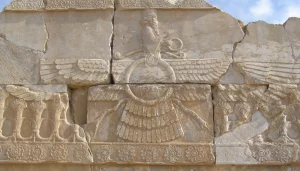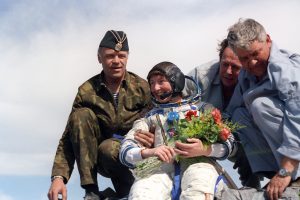Many people know of the Mexican holiday Día de Los Muertos, which is filled with vibrant colors and intricately painted faces. What many people don’t know is that this holiday originated over 3000 years ago with the Aztec empire. The Spanish Conquistadors first recorded a Día de Los Muertos celebration during the 16th century. When the Aztecs had begun this tradition, they weren’t remembering loved ones who passed, but they were worshiping the queen of the underworld and protector of the dead.1

This Aztec queen was Mictecacihuatl, “Lady of the Dead,” Queen of Mictlan.2 According to Aztec legend, Mictecacihuatl was sacrificed as an infant and placed in the underworld to become the wife of Miclantecuhtl, the king of the underworld. In the underworld, her role was to watch over the bones of past lives, which would be used to create new life in the living world. However, in order for the bones to be able to create new life, they needed to be stolen from Mictecacihuatl to be brought to the living world. As their protector, part of her own life would be carried with the stolen bones. Even after the bones were stolen, she would continue her duty to protect them by returning to the living world every year to make sure the bones were being properly taken care of. When the time came for her to return to the living world, the Aztecs celebrated Mictecacihuatl’s return with death festivals and traditional dances, to honor her for her protection of the bones that created life and to seek protection for those who died.3

The Aztecs celebrated Día de Los Muertos much differently than it is celebrated today due to the Spanish conquistadors and Catholicism. The Spanish changed the lives of the indigenous peoples wherever they went, from taking land for the Spanish throne to converting people to Catholicism. Many traditions changed, including those of Día de Los Muertos.4 The Aztecs laid out offerings for the King and Queen of the Underworld for the whole month of August, and the Spanish were the first outsiders to witness this honoring of Mictecacihuatl by the Aztecs. Not long after the Spanish exposure to this festival, the Spanish combined the Aztec tradition with Catholicism. Syncretism, the blending of Spanish and indigenous beliefs and practices, combined the Aztec traditions of Día de Los Muertos with the Spanish traditions of All Saint’s Day and All Souls Day.5 Some examples of syncretism between Catholicism and Día de Los Muertos are the symbols that are most recognizable with Día de Muertos, such as decorated skulls and skeletons, and the Spanish character “La Catrina,” who represents Mictecacihuatl.6 The merging of Catholicism with the Aztec religious beliefs began the evolution of how Día de Los Muertos, transforming how it is celebrated today.

Despite that the name Día de Los Muertos translates to Day of the Dead in English, the holiday is actually the celebration of life. Día de Los Muertos doesn’t focus on death and mourning of a loved one. It’s seen as a happy celebration where family members of all generations, deceased and alive, can be together as one. The traditions of this holiday have changed from honoring the queen of the underworld Mictecacihuatl to honoring those who have passed.7 It’s a time of colorful festivals and parades, beautifully painted colorful skulls, marigold flowers, decorated ofrendas, grave site visits and the smells of traditional Mexican foods and incense in the air. Although it is primarily celebrated in Mexico, some parts of the United States, especially cities and towns on the Mexican border, have adopted the tradition and celebrate the remembrance of their deceased loved ones.
- MasterFILE Complete, 2008, s.v. “Día de los Muertos, by Benjamin Perea. ↵
- Sin Jones, Mictecacihuatl, Santa Muerte, 2010, 1-16. ↵
- Sin Jones, Mictecacihuatl, Santa Muerte, 2010, 1-16. ↵
- Mark Lacy, Origins of El Día de Los Muertos: The Prehispanic Festival of the Dead Defies Cultural Invasions of Mexico, (History Institute for Culture), 1. ↵
- Mark Lacy, Origins of El Día de Los Muertos: The Prehispanic Festival of the Dead Defies Cultural Invasions of Mexico, (History Institute for Culture), 1. ↵
- Mark Lacy, Origins of El Día de Los Muertos: The Prehispanic Festival of the Dead Defies Cultural Invasions of Mexico, (History Institute for Culture), 1. ↵
- Christina Zarate, Día de Los Muertos, (Smithsonian National Museum of American History), 2-7. ↵



114 comments
Mia Morales
I enjoyed reading this article because being Hispanic it is always fascinating to learn more about my culture and its background. I did not know that Dia de Los Muertos was originated from the Aztec Empire and was not what it is today. It is interesting to see how this Mexican holiday transformed to this beautiful and colorful festival it is today while still having many factors that Aztecs practiced over 3000 years ago.
Alexandra Lopez
Reading this article has informed the origins of Día de Los Muertos and how much it has changed because of Spaniard/Catholic influence. This article is well written and enlightening about Día de Los Muertos that is celebrated all over Mexico/some parts of the United States. I am glad I read this because my knowledge about Día de Los Muertos only extends to the Disney movie “Coco.” (reposted)
Gabrien Gregory
I learned so much about Dia De Los Muertos from this article. I think this an important read for anyone who wants to learn more about cultures, especially for those living in Texas or San Antonio. I know the significance of this tradition through my girlfriend and her family. I have always found this incredible, the idea one can celebrate who they are by celebrating those ancestors who came before them. That is real honor for those in heritage.
Arieana Martinez
My family has always celebrated Dia De Los Muertos, but I had no idea of its Aztec origin. This is a very strong story, as this day has a totally new meaning, as it highlights the Lady of the Dead’s strength and willingness to sacrifice herself so that people may have the chance to live. I enjoyed the progression of the story and how Dia De Los Muertos started in relation to how it is celebrated today. Although this article was short, I thought it was right to the point and did not need to expand any further on the details that were presented. Loved reading this!
Stephanie Nava
This is a great article! I never knew exactly what the origins of Dia de Los Muertos are. It is truly a beautiful holiday in Mexican culture. I never knew what the Aztecs celebrated for, and I like how the author describes that what we celebrate to day is a mixture of Spanish and Aztec culture. It is ironic how it is called The Day of the Dead when the holiday is actually celebrating life. I love it!
Max Lerma
This was a great article! I have heard of the Dia de Los Muertos celebration, but have never celebrated it myself. My grandmother who comes from interior Mexico would tell us stories about how she and her family would celebrate it when she was younger and they still resided in Mexico. I really enjoyed reading your article and how you gave not only the origin of the celebration, but also how the Spanish conquistadors adopted it and changed it. Your article is a fascinating read and it keeps you wanting to learn more about the celebration throughout the entire piece.
Mia Stahl
The day of the dead is a holiday that has been celebrated in my family for many years. I have known about its origins but this brought to my attention much more that I had never heard of before. The heritage of my people is one of the most beautiful and rich in the world. A culture that recognizes its family to beyond the grave is one that holds high respect for their lineage and strives to keep it as strong as it can be.
Irene Astran
I never celebrated this holiday until I moved to Texas. Although I am of Mexican decent I suppose I was growing up to far from people who knew of these traditions. I appreciate that you chose to write about this topic as I am sure there are several Texans who celebrate that do not know the origins of such practices.
Miguel Camarillo-Cohen
I had no idea that El Dia de Los Muertos, a Mexican, Central, and Latin tradition, was adapted by Chicanos in the U.S. as well as originating during the Aztec’s. The author does an excellent job of laying how the celebration evolved and transformed to the current celebration. It was interesting to learn that the transformation of the Dia de Los Muertos took part when the Spanish conquistadors blended their traditions and the Aztec’s to make it what it is today.
Nathan Hartley
I have never really understood the day of the dead celebration. I think it’s a cool idea for a holiday, but I just don’t really understand it. I do think that the way my family has funerals is a similar thing to the holiday because we celebrate their life as a part of their funeral.